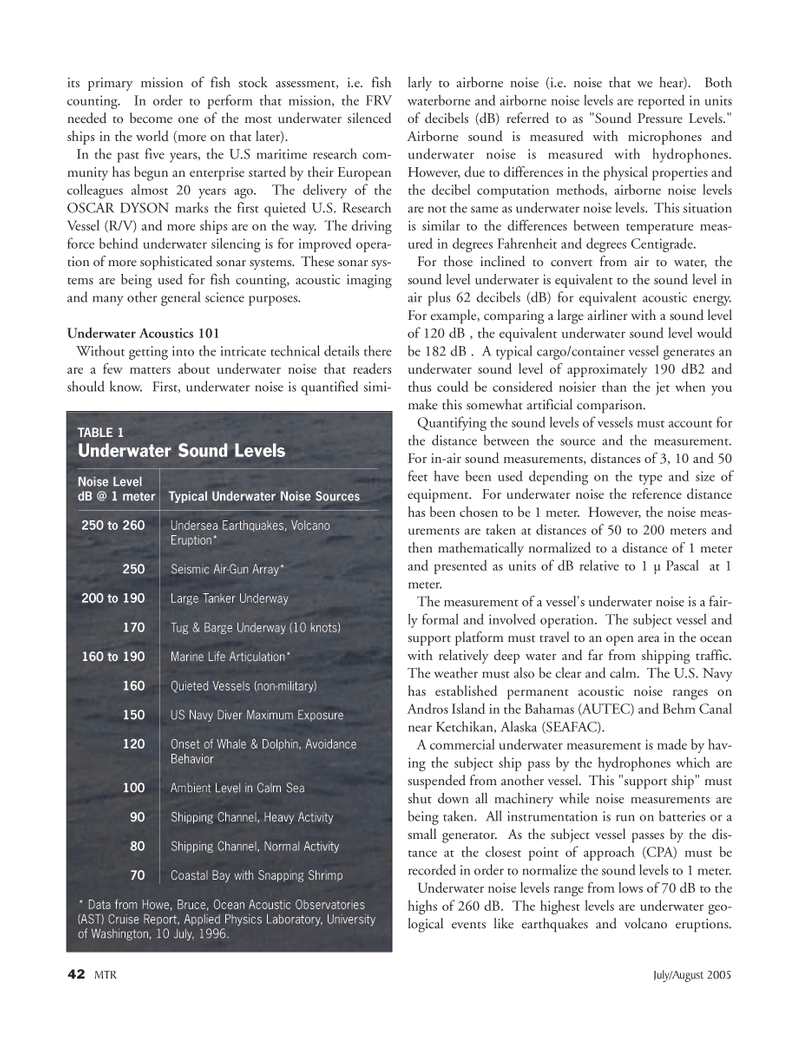
Page 41: of Marine Technology Magazine (July 2005)
Read this page in Pdf, Flash or Html5 edition of July 2005 Marine Technology Magazine
42 MTR July/August 2005 its primary mission of fish stock assessment, i.e. fish counting. In order to perform that mission, the FRV needed to become one of the most underwater silenced ships in the world (more on that later).
In the past five years, the U.S maritime research com- munity has begun an enterprise started by their European colleagues almost 20 years ago. The delivery of the
OSCAR DYSON marks the first quieted U.S. Research
Vessel (R/V) and more ships are on the way. The driving force behind underwater silencing is for improved opera- tion of more sophisticated sonar systems. These sonar sys- tems are being used for fish counting, acoustic imaging and many other general science purposes.
Underwater Acoustics 101
Without getting into the intricate technical details there are a few matters about underwater noise that readers should know. First, underwater noise is quantified simi- larly to airborne noise (i.e. noise that we hear). Both waterborne and airborne noise levels are reported in units of decibels (dB) referred to as "Sound Pressure Levels."
Airborne sound is measured with microphones and underwater noise is measured with hydrophones.
However, due to differences in the physical properties and the decibel computation methods, airborne noise levels are not the same as underwater noise levels. This situation is similar to the differences between temperature meas- ured in degrees Fahrenheit and degrees Centigrade.
For those inclined to convert from air to water, the sound level underwater is equivalent to the sound level in air plus 62 decibels (dB) for equivalent acoustic energy.
For example, comparing a large airliner with a sound level of 120 dB , the equivalent underwater sound level would be 182 dB . A typical cargo/container vessel generates an underwater sound level of approximately 190 dB2 and thus could be considered noisier than the jet when you make this somewhat artificial comparison.
Quantifying the sound levels of vessels must account for the distance between the source and the measurement.
For in-air sound measurements, distances of 3, 10 and 50 feet have been used depending on the type and size of equipment. For underwater noise the reference distance has been chosen to be 1 meter. However, the noise meas- urements are taken at distances of 50 to 200 meters and then mathematically normalized to a distance of 1 meter and presented as units of dB relative to 1 µ Pascal at 1 meter.
The measurement of a vessel's underwater noise is a fair- ly formal and involved operation. The subject vessel and support platform must travel to an open area in the ocean with relatively deep water and far from shipping traffic.
The weather must also be clear and calm. The U.S. Navy has established permanent acoustic noise ranges on
Andros Island in the Bahamas (AUTEC) and Behm Canal near Ketchikan, Alaska (SEAFAC).
A commercial underwater measurement is made by hav- ing the subject ship pass by the hydrophones which are suspended from another vessel. This "support ship" must shut down all machinery while noise measurements are being taken. All instrumentation is run on batteries or a small generator. As the subject vessel passes by the dis- tance at the closest point of approach (CPA) must be recorded in order to normalize the sound levels to 1 meter.
Underwater noise levels range from lows of 70 dB to the highs of 260 dB. The highest levels are underwater geo- logical events like earthquakes and volcano eruptions.
TABLE 1
Underwater Sound Levels
Noise Level dB @ 1 meter Typical Underwater Noise Sources 250 to 260 Undersea Earthquakes, Volcano
Eruption* 250 Seismic Air-Gun Array* 200 to 190 Large Tanker Underway 170 Tug & Barge Underway (10 knots) 160 to 190 Marine Life Articulation* 160 Quieted Vessels (non-military) 150 US Navy Diver Maximum Exposure 120 Onset of Whale & Dolphin, Avoidance
Behavior 100 Ambient Level in Calm Sea 90 Shipping Channel, Heavy Activity 80 Shipping Channel, Normal Activity 70 Coastal Bay with Snapping Shrimp * Data from Howe, Bruce, Ocean Acoustic Observatories (AST) Cruise Report, Applied Physics Laboratory, University of Washington, 10 July, 1996.
MTR#1 (33-48).qxd 7/19/2005 9:59 AM Page 42

 40
40

 42
42
